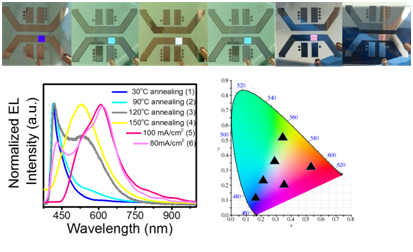For years, organic light-emitting diodes (OLEDs) have attracted considerable attention as a potential next-generation solid-state lighting source. However, white OLEDs have shown problems with color instability, high cost of materials and a complex fabrication process.
Research conducted by Professor Wang Xianglin of the Department of Materials Science and Engineering (MSE) at Southern University of Science and Technology (SUSTech) has made new progress in this field. His research group has developed a novel, temperature-sensitive single-molecule, full-spectrum luminescent material that adopts a tunable emissions material. Their paper, published in Advanced Materials, is entitled “Multiphotoluminescence from a Triphenylamine Derivative and Its Application in White Organic Light-Emitting Diodes Based on a Single Emissive Layer.”
Traditionally, white OLEDs have required the simultaneous display of several colors. Most OLEDs have emitted red, green and blue light (RGB) at the same time. At the very least, blue and orange can be emitted at the same time, as they are complementary colors. The industry has adopted a variety of different device architectures to develop efficient white light emitting systems, but these designs struggle from a limited choice of materials, complex structures, and high costs.

The research group opted to circumvent the existing problems of stacked white OLED devices by demonstrating a unique single organic molecular-based white OLED device. Their OLED device employs a tunable emission material called tris(4-(phenylethynyl)phenyl)amine (TPEPA). TPEPA has a single crystal and electronic structure that had been discussed by researchers in the past, but Professor Wang Xianglin’s research group was the first to discover that TPEPA can emit different colors at different annealing temperatures and times.
This discovery may pave the way for the next generation of low cost and simple white OLED technology, furthering industrial prospects in illumination and illumination devices. Professor Wang Xianglin and his research team will continue to research this exciting field, as their new discovery has simplified the process of manufacturing white OLEDs while reducing their cost and improving their performance.
Professor Wang Xianglin’s research group worked with Professor Zhang Zhaoyu from Chinese University of Hong Kong’s School of Science and Engineering, Professor Kim from Ulsan National Institute of Science and Technology’s Center for Super-functional Materials and Professor Xu Hu from the Department of Physics at SUSTech.
Professor Wang Xianglin’s research group were supported in their research by the Shenzhen Key Laboratory Project and the Leading Talents of Guangdong province program.
Original article: https://doi.org/10.1002/adma.201900613






